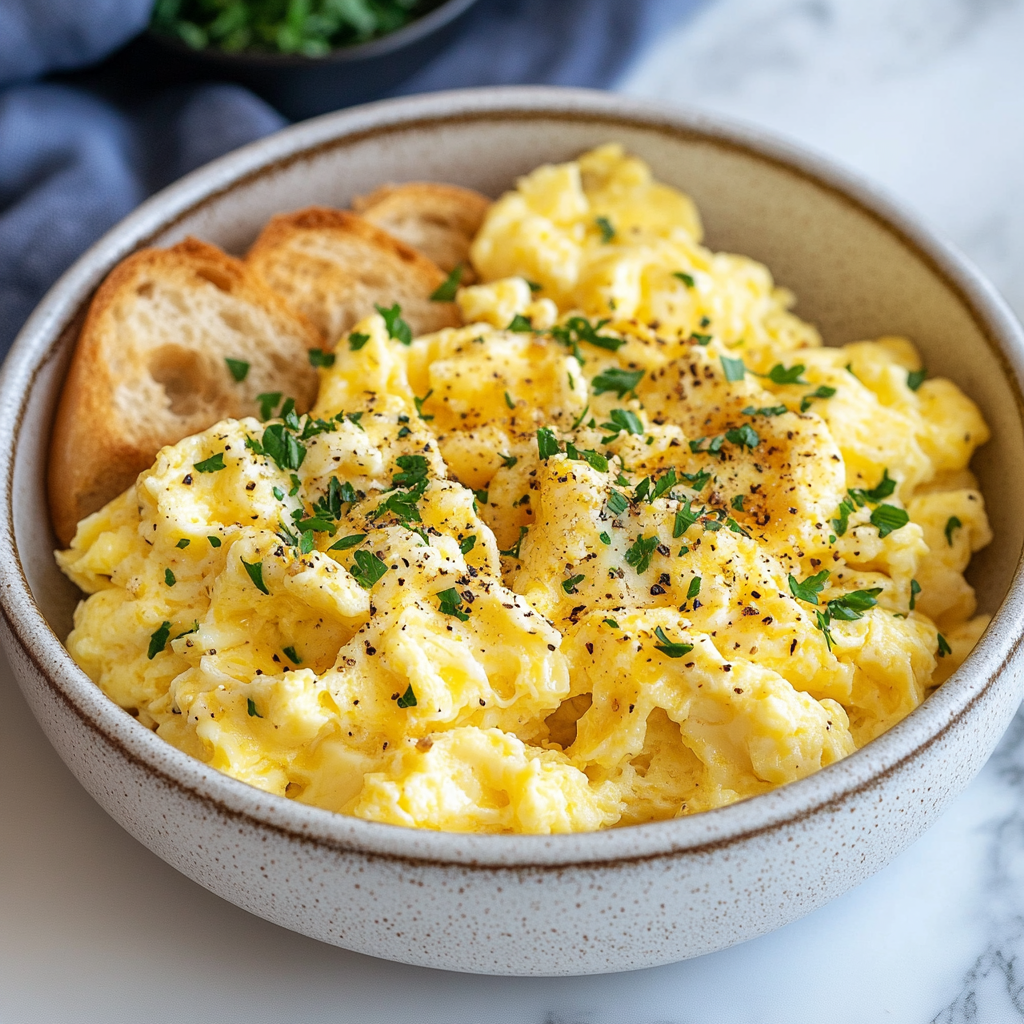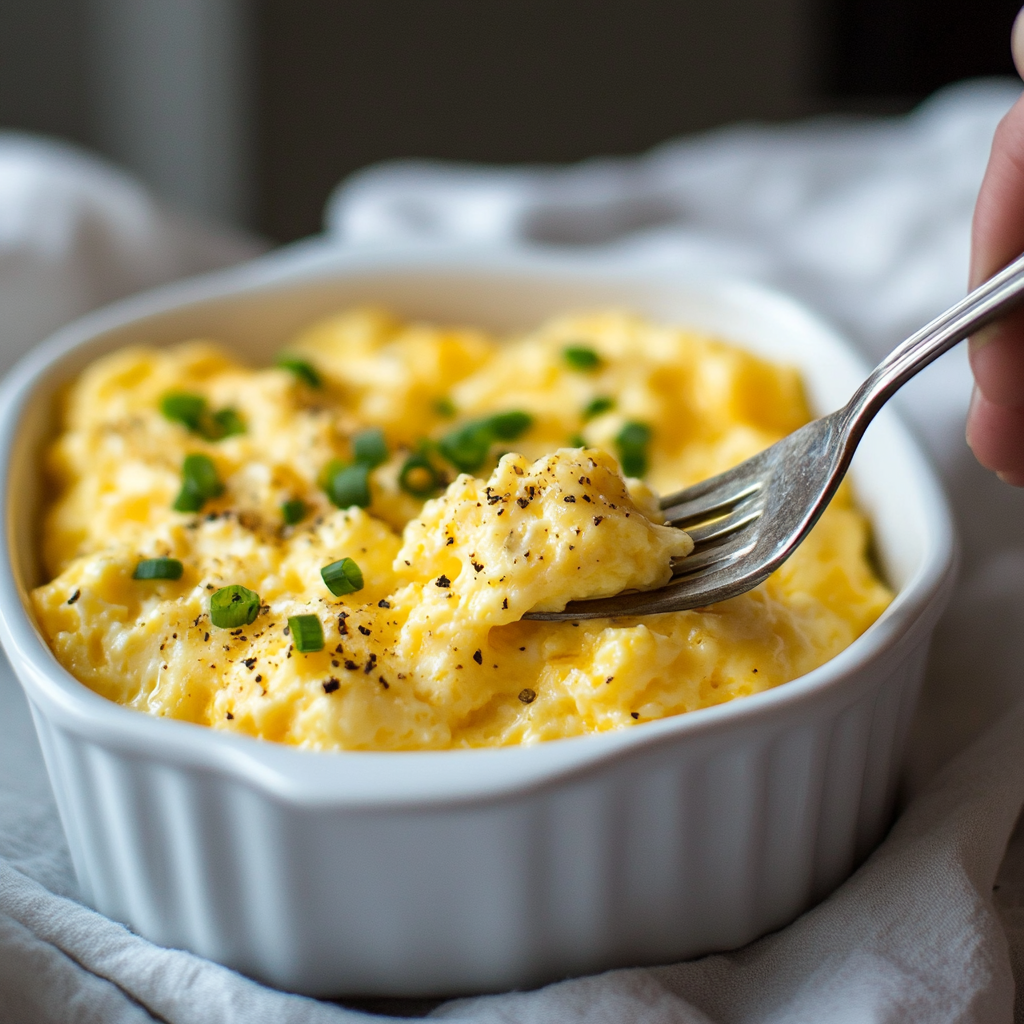A creamy, cheesy breakfast favorite that’s easy to prepare and full of flavor.
Introduction
Classic scrambled eggs with cheese are a breakfast staple loved for their creamy texture and savory flavor. Whether you’re cooking for yourself or serving a family, this recipe is quick, simple, and endlessly customizable. Packed with protein and cheese’s gooey goodness, it’s a dish that pairs perfectly with various sides and beverages. In this article, we’ll dive deep into crafting the perfect scrambled eggs with cheese, from ingredient tips to cooking techniques, storage options, and exciting variations.

Preparation and Cooking Details
- Prep Time: 5 minutes
- Cook Time: 5 minutes
- Total Time: 10 minutes
- Servings: 2
Why You Will Love This Recipe
- Quick and Easy: Ready in just 10 minutes, making it perfect for busy mornings.
- Customizable: Use your favorite cheese or add mix-ins like herbs and veggies.
- Protein-Packed: A nutritious way to start the day.
- Comforting Flavor: The perfect blend of creaminess and cheesiness.
- Versatile: Suitable for breakfast, brunch, or even a light dinner.
Ingredients Notes
Here’s a breakdown of the key ingredients:
- Eggs: Use large, fresh eggs for the best texture and flavor.
- Cheese: Cheddar, mozzarella, or Swiss work wonderfully, but feel free to experiment with your favorites.
- Milk or Cream: Adds richness and helps achieve a fluffier texture.
- Butter: Prevents sticking and enhances flavor.
- Seasoning: A pinch of salt and pepper brings out the natural flavors of the eggs and cheese.
How to Make Classic Scrambled Eggs with Cheese
Follow these detailed steps to create perfectly creamy and cheesy scrambled eggs:
- Prepare the Ingredients:
- Crack the eggs into a bowl and whisk thoroughly until the yolks and whites are fully combined. Add a splash of milk or cream, a pinch of salt, and a dash of pepper. Whisk again to incorporate air, which will make the eggs fluffy.
- Heat the Pan:
- Use a non-stick skillet over low to medium heat. Add a knob of butter and let it melt, coating the pan evenly.
- Cook the Eggs:
- Pour the egg mixture into the pan. Let it sit for a few seconds until it begins to set around the edges.
- Using a spatula, gently push the eggs from the edges toward the center, creating soft folds. Repeat this process until the eggs are mostly cooked but still slightly runny.
- Add the Cheese:
- Sprinkle shredded cheese over the eggs. Fold gently to incorporate the cheese into the eggs. Remove from heat while the eggs are still creamy, as they will continue to cook slightly from residual heat.
- Serve Immediately:
- Transfer the scrambled eggs to a plate and garnish with fresh herbs like chives or parsley, if desired. Serve hot with your favorite sides.
Storage Options
- Refrigeration: Store leftover scrambled eggs in an airtight container in the fridge for up to 2 days. Reheat gently in a microwave or on the stovetop with a little butter.
- Freezing: While not ideal due to texture changes, you can freeze scrambled eggs for up to 1 month. Thaw overnight in the refrigerator before reheating.
Variations and Substitutions
Substitutions for Ingredients
- Replace milk or cream with plant-based alternatives like almond milk or oat milk.
- Use olive oil instead of butter for a lighter option.
- Substitute your preferred cheese, such as feta or gouda.
Regional or Cultural Variations
- French-Style: Cook the eggs low and slow for an ultra-creamy texture.
- Mexican-Style: Add diced jalapeños, tomatoes, and a sprinkle of cotija cheese.
- Italian-Style: Incorporate Parmesan cheese and fresh basil.
Creative Twists for Adventurous Cooks
- Add sautéed mushrooms, spinach, or diced ham for extra flavor and nutrition.
- Spice it up with a dash of hot sauce or a sprinkle of smoked paprika.
- Try a mix of cheeses for a more complex flavor profile.
Pairings and Accompaniments
- Sides: Toast, hash browns, or a fresh salad.
- Beverages: Orange juice, coffee, or a refreshing smoothie.
- Complementary Dishes: Pair with avocado toast for a complete meal.
Comparison with Similar Recipes
Unlike basic scrambled eggs, this recipe stands out for its rich, cheesy flavor and creamy texture. While omelets and frittatas are structured and firm, these scrambled eggs are soft and indulgent. Additionally, the added cheese makes them more satisfying than plain scrambled eggs.

Frequently Asked Questions (FAQs)
What kind of cheese is good on scrambled eggs?
Cheddar, mozzarella, Swiss, and feta are all excellent choices. Each brings a unique flavor and texture.
Does egg with cheese taste good?
Yes! The creaminess of cheese complements the eggs’ soft texture, creating a delicious and satisfying dish.
What are the nutrition facts of scrambled eggs with cheese?
A serving (2 eggs + 1 oz cheese) provides approximately 200 calories, 14g protein, and 16g fat. Adjust based on ingredients.
What makes scrambled eggs taste better?
Using fresh eggs, adding a splash of milk or cream, cooking over low heat, and seasoning well are key to enhancing flavor.
Best Time to Enjoy the Recipe
Scrambled eggs with cheese are versatile and can be enjoyed for breakfast, brunch, or even dinner. They’re a perfect choice for a quick, hearty meal at any time of day.
Presentation Tips
- Serve the eggs on a warm plate to maintain their temperature.
- Garnish with fresh herbs for a pop of color and added flavor.
- Pair with colorful sides like sliced avocado or a fruit salad for visual appeal.
Suggested Recipes
For more savory recipes you can also check my friend Alicia’s blog here www.ledstk.com.
